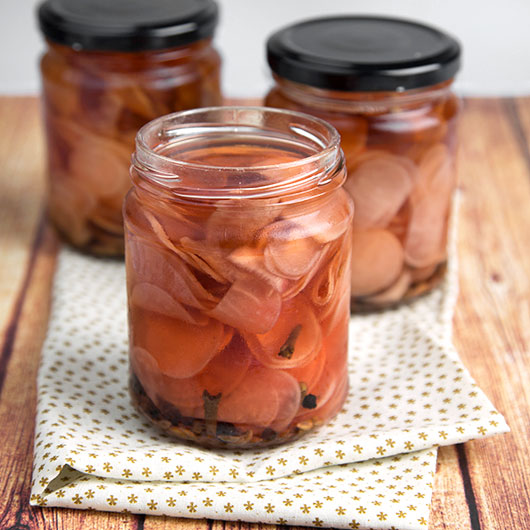I had a short but sweet list of New Year’s resolutions at the start of the year which including making and eating more fermented foods. Kombucha, milk/water kefir and home-made yoghurt have become staples in my diet since then and I’ve also now got a “science experiment” corner in the kitchen where something or other is bubbling away towards being deliciously sour, fermented goodness.
There’s many different starters you can use for fermenting and this is the simplest lacto-fermentation starter method of all with only two easy-to-find ingredients – Celtic sea salt (non-iodised) and filtered or spring water. Add a couple of bunches of salad radishes (8-12 small, round radishes) and a little bit of patience and then watch the magic of cultured vegetables happen!.


I’ve made these lacto-fermented radishes a few times now, fiddling around with the spices and amounts of each to use and I think I’ve got it licked. Peppery and delectably sour, I love to add some cultured vegetables to leafy garden salads or sandwiches, or wrap some up in rice paper rolls with chicken and vegetables. Play around with your mandolin/food processor settings for your favourite thickness. This batch was a little too thin for my liking – I like my fermented radishes cut a little thicker so they stay even crunchier.
This post is part of the monthly link up party Our Growing Edge. This event aims to connect food bloggers and inspire us to try new things. This month is hosted by Becky from My Utensil Crock.
- 3 cups boiling water
- 2 tbsp celtic sea salt
- 2 bunches of salad radishes, washed and tops and tails removed
- 1 tsp whole cloves
- 1 tsp whole peppercorns
- ½ tsp caraway seeds
- Make brine by dissolving the sea salt in water and put aside to cool. Wash and sterilise 3 250ml capacity jars. Mix spices together in a small bowl and set aside.
- Thinly slice radishes with a mandolin or food processor slicing attachment. Distribute mixed spices between the three jars then pack the sliced radishes on top and pour cooled brine over the top and leave 2cm headspace.
- Push any floating radish under the water and weigh down with small saucer or jar lid, stone, small cup filled with water or crumpled baking paper. Cover tightly and allow to ferment for a minimum of 3-4 days or until fermented, bubbly and sour (I left mine to culture for about a week). Store in a cool, dark place (where it will continue fermenting), or in the fridge.


Comments 6
I’ve only heard about lacto-fermentation recently and find it intriguing, though still a bit nervous about trying. These radishes look really good!
Author
I’ve been where you are Leaf and believe me that it’s not as scary as it seems – it just takes some trial and error to find what fermented foods you would like to eat or drink and which fit in best with your lifestyle.
Kombucha and lacto-fermented vegies are my fav to make and eat as they take hardly any effort and I don’t have to remember to check on them more than every few days 🙂
Thanks for the comment Leaf!
Great submission to Our Growing Edge. This is very much outside of my comfort zone. I only learned about kombucha this year and while fermenting is on my foodie bucket list, it is still yet to be ticked off. I know that fermenting is magic and preserves food, but for how long?
Author
It is pretty magic Genie, and the best part it practically preserves the food forever due to the presence of beneficial bacteria that contribute to fermentation. Generally the worse thing that happens is that the longer you allow it to ferment (the longer you store it) the more sour it becomes – eventually becoming vinegar-like.
Thanks for the comment, and thank you for letting me participate in Our Growing Edge!
Pingback: Hosting: Our Growing Edge … Round-up!
Pingback: 37 Ferments for Spring — Traditional Cooking School by GNOWFGLINS